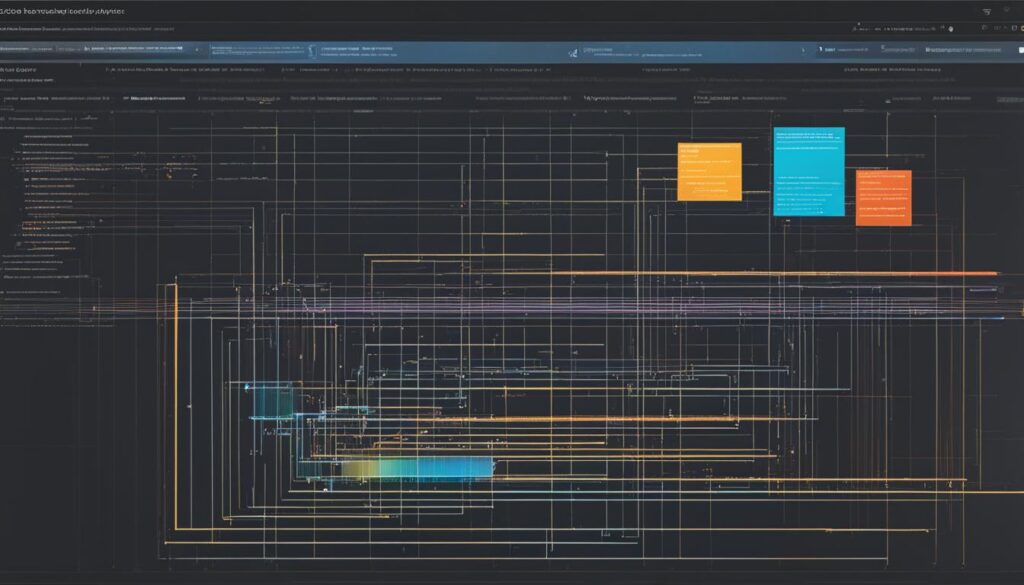In the field of software development, the significance of code quality cannot be overstated. It plays a crucial role in the reliability, efficiency, and security of the software we develop. This is why static code analysis is so important. By using this effective method, we can improve the quality of our code by detecting errors, enhancing performance, and adhering to secure coding practices.
Static code analysis allows us to catch potential issues early in the development process. By analyzing the source code without executing it, we can identify bugs and vulnerabilities, ensuring a higher level of code quality. With the help of code review tools and automated testing, we can implement software engineering best practices and achieve robust and efficient code.
Key Takeaways:
- Static code analysis is a powerful tool for enhancing code quality in software development.
- It enables early bug detection, performance optimization, and enforcement of secure coding practices.
- Code review tools and automated testing play a crucial role in implementing static code analysis.
- By incorporating static code analysis into our development process, we can achieve higher code quality and efficiency.
- Static code analysis is an essential practice for software engineering best practices and cost savings in bug fixes.
What is Static Code Analysis?
Static code analysis is a crucial process in software development that enables us to examine the source code for potential issues before it is executed. By analyzing the code directly, static code analysis helps us identify vulnerabilities, errors, and deviations from coding standards, allowing for early detection of issues and ensuring compliance with industry best practices.
Through static code analysis, we can achieve code consistency, improve code security, and save costs by addressing issues early in the development cycle. By detecting and resolving vulnerabilities at an early stage, we can prevent potential security breaches and enhance the overall quality of our software.
This process plays a vital role in maintaining coding standards and reducing the risk of coding errors. By employing static code analysis techniques, we can identify and rectify potential issues in the source code, such as coding flaws, coding rule violations, and other vulnerabilities.
Static code analysis is an essential component of software testing as it helps us detect and fix issues at the earliest stage of development. By leveraging the power of static code analysis, we can ensure the reliability, security, and maintainability of our software applications.
Incorporating static code analysis into our software development practices enables us to deliver high-quality code, eliminate potential vulnerabilities, and achieve greater efficiency in the development process. By proactively addressing issues and adhering to coding standards, we can build robust and secure software applications that meet the highest industry standards.
How Static Code Analysis Works
Static code analysis is a crucial part of the software development process, helping developers improve code quality and identify potential issues before execution. It involves a series of steps that begin with the input of source code files into a static analysis tool.
The first step in static code analysis is the scanning of the source code by a compiler. The compiler breaks down the code into tokens and creates an abstract syntax tree (AST), which represents the structure of the code.
Once the AST is created, the static analysis tool performs various code checks to identify potential issues. These checks include:
- Syntax Analysis: This involves examining the code for syntax errors and violations of coding standards.
- Data Flow Analysis: It tracks the flow of data through the code to detect issues such as uninitialized variables and data race conditions.
- Control Flow Analysis: This analysis examines the program’s control flow paths to identify bugs like infinite loops and unreachable code.
- Security Vulnerability Analysis: It checks for potential security vulnerabilities, such as buffer overflows and injection attacks.
After analyzing the code, the static analysis tool generates a report that highlights the issues found, often with a severity rating. This report provides developers with actionable information to improve code quality, prioritize fixes, and ensure the overall reliability and security of the software.
By following these steps, static code analysis plays a crucial role in preventing potential bugs, improving code quality, and ensuring the overall efficiency and reliability of software development.
Benefits of Static Code Analysis
Static code analysis provides numerous advantages for software development teams. By leveraging this technique, we can achieve code consistency, enhance code security, save costs, improve code maintainability, and elevate overall code quality.
Ensuring Code Consistency and Best Practices
“Consistency is the key to successful software development.”
Static code analysis enforces coding standards and best practices across the entire codebase. It helps identify deviations from established guidelines and ensures consistent coding styles and patterns. By adhering to these standards, teams can develop cleaner and more maintainable code, leading to increased efficiency and better collaboration.
Enhancing Code Security
“A secure code is a strong fortress.”
Security vulnerabilities can be costly and damaging. Static code analysis helps identify potential security risks and vulnerabilities early in the development process by scanning the code for weaknesses and insecure practices. By proactively detecting and addressing these issues, we can significantly reduce the risk of data breaches, safeguard sensitive information, and protect our applications and users.
Saving Costs
“Prevention is better than cure when it comes to software development.”
Static code analysis plays a vital role in detecting and fixing issues early in the development lifecycle. By identifying bugs, code smells, and potential performance bottlenecks before deployment, we can save significant costs associated with bug fixes, debugging, and maintenance. Moreover, addressing issues early minimizes the risk of downstream dependencies, reducing the complexity and expenses of resolving complex issues later on.
Improving Code Maintainability
“Code should be written for humans first, and computers second.”
Static code analysis helps improve code maintainability by detecting and suggesting improvements for code readability, duplication, and complexity. By addressing these code quality issues, developers can ensure that the codebase remains clean and scalable throughout the software’s lifecycle. This leads to reduced technical debt, easier code review processes, and smoother future enhancements and updates.
Elevating Code Quality
Static code analysis assists in achieving higher code quality by identifying potential issues early on. By scanning the codebase for bugs, potential errors, and non-compliant practices, we can ensure that the code meets the highest standards of reliability and performance. With improved code quality, we can deliver robust and efficient software that satisfies user expectations and industry standards.
Overall, static code analysis significantly contributes to the success of software development projects. It promotes code consistency, enhances code security, saves costs, improves code maintainability, and elevates code quality, leading to efficient and reliable software products.
| Benefits of Static Code Analysis |
|---|
| Code Consistency |
| Code Security |
| Cost Savings |
| Code Maintainability |
| Code Quality |
Potential Limitations of Static Code Analysis
Static code analysis is a valuable tool that helps improve code quality and reliability in software development. However, it is essential to understand the potential limitations of this technique to effectively leverage its benefits. Here are some key limitations to consider:
False Positives
False positives occur when static code analysis tools flag code segments as problematic, even though they are not. This can result in wasted time and effort spent investigating and addressing non-existent issues.
False Negatives
On the other hand, false negatives occur when static code analysis fails to detect actual issues in the code. This can lead to undetected bugs or security vulnerabilities, posing potential risks and compromising the overall code quality.
Tool Limitations
Static code analysis tools have limitations based on their rulesets and capabilities. Some tools may miss certain types of issues or have limited coverage for specific programming languages or frameworks. It’s crucial to choose the right tool that aligns with your project’s requirements and consider using multiple tools when necessary.
To overcome these limitations, software development teams should combine static code analysis with other testing techniques, such as dynamic testing and manual code review. This multi-faceted approach ensures comprehensive code quality assurance and reduces the risk of missing critical issues.
By understanding the potential limitations and complementing static code analysis with other methods, we can maximize its benefits and achieve higher code quality in software development.
Best Practices for Effective Static Code Analysis
At [Company Name], we believe that maximizing the effectiveness of static code analysis requires a multi-faceted approach. While static code analysis is a powerful tool for improving code quality, it can be further enhanced when used in combination with other testing techniques and the establishment of internal code quality standards.
Dynamic Testing
Dynamic testing involves running the software and executing various test cases to observe its behavior. By complementing static code analysis with dynamic testing, we can uncover runtime issues and validate the functionality of the code in real-world scenarios. This testing approach provides additional layers of assurance and helps identify potential issues that static code analysis may miss.
Manual Code Review
While automated static code analysis tools are valuable, human intelligence and manual code review play an essential role in identifying complex issues and assessing code quality. Manual code review allows developers to dive deep into the codebase, inspecting the logic, structure, and implementation details that automated tools may overlook. By performing thorough code reviews, we can ensure that the code adheres to coding standards, best practices, and specific project requirements.
Human Testing
Human testing, often performed by quality assurance (QA) professionals or user acceptance testers, involves evaluating the software from an end-user perspective. By incorporating human testing into the testing process, we can assess the software’s usability, functionality, and overall user experience. Human testers can provide valuable feedback, identify usability issues, and validate the software’s behavior against real-world user scenarios.
Code Quality Standards
Establishing internal code quality standards and guidelines is crucial for effective static code analysis. These standards provide a set of rules and best practices that developers should follow, ensuring consistency, maintainability, and readability of the codebase. By adhering to code quality standards, we can minimize code issues, enhance code maintainability, and streamline the development process.
“Combining static code analysis with dynamic testing, manual code review, and human testing enables us to maximize code quality and deliver robust software that meets our clients’ expectations.”
To illustrate the effectiveness of utilizing multiple testing techniques, we have created a table outlining the comparison between static code analysis, dynamic testing, manual code review, and human testing:
| Testing Technique | Advantages | Limitations |
|---|---|---|
| Static Code Analysis | – Early detection of code issues – Scalable for large codebases – Automated and efficient |
– Limited coverage on runtime behaviors – False positives or negatives may occur |
| Dynamic Testing | – Evaluates software in real-world scenarios – Uncovers runtime issues – Validates functionality |
– Time-consuming and resource-intensive – Requires careful test case design – Can’t check 100% of code paths |
| Manual Code Review | – Human intelligence for complex issues – Validates adherence to coding standards – Identifies logic flaws and implementation details |
– Subjective nature of reviews – Time-consuming for large codebases – Prone to human error |
| Human Testing | – Assesses user experience and usability – Validates software against real-world scenarios – Provides valuable user feedback |
– Requires diverse user perspectives – May overlook specific edge cases – Not comprehensive for large systems |
By combining these testing techniques and leveraging the insights gained from each approach, we can achieve comprehensive code quality assurance, faster development cycles, and ultimately deliver high-quality software that meets the needs of our clients and users.

Static Code Analysis Techniques Overview
Static code analysis encompasses several techniques for identifying potential problems in code. Let’s explore some of these techniques:
Syntax Analysis
Syntax analysis checks for syntax errors and coding standards violations in the code. It ensures that the code follows the correct syntax defined by the programming language, preventing common mistakes and improving code readability.
Data Flow Analysis
Data flow analysis tracks the flow of data through the code to detect issues such as uninitialized variables and data race conditions. By analyzing how data is used and modified within the code, data flow analysis helps identify potential bugs and logical errors.
Control Flow Analysis
Control flow analysis examines the program’s control flow paths to identify bugs like infinite loops and unreachable code. It helps developers understand how the program executes and identifies areas where code may not behave as expected.
Security Analysis
Security analysis focuses on identifying potential security vulnerabilities in the code. It checks for common security issues such as buffer overflows, injection attacks, and insecure cryptographic algorithms. By detecting these vulnerabilities early, developers can ensure that their code is secure and protected.
Using a combination of these static code analysis techniques, developers can proactively identify and address potential issues in their code, improving code quality and reducing the likelihood of bugs and security vulnerabilities.
- Syntax analysis checks for syntax errors and coding standards violations.
- Data flow analysis tracks the flow of data through the code to detect issues such as uninitialized variables and data race conditions.
- Control flow analysis examines the program’s control flow paths to identify bugs like infinite loops and unreachable code.
- Security analysis checks for potential security vulnerabilities, such as buffer overflows and injection attacks.
By leveraging these static code analysis techniques, developers can ensure that their code is robust, secure, and of high quality.
Static Code Analysis Tools
In the world of software development, static code analysis tools are invaluable resources for enhancing code quality and efficiency. These tools help developers identify and address potential issues in their code, resulting in more reliable and secure software. Let’s explore some popular static code analysis tools:
SonarQube
SonarQube is a comprehensive code quality management platform that supports a wide range of programming languages. It provides developers with continuous feedback on code quality, highlighting bugs, vulnerabilities, and code smells. SonarQube integrates seamlessly into existing development workflows, making it a popular choice among software teams.
Checkstyle
Checkstyle focuses on enforcing coding standards and conventions. It performs a variety of checks to ensure consistency in code formatting, naming conventions, and documentation. By integrating Checkstyle into the development process, teams can maintain a high level of code quality and readability.
FindBugs
FindBugs is a static code analysis tool that specializes in detecting potential bugs in Java programs. It analyzes bytecode to identify common coding mistakes, such as null pointer dereferences, resource leaks, and synchronization issues. FindBugs helps developers catch these bugs early, ensuring the production of robust and reliable Java code.
PMD
PMD is another popular static code analysis tool for Java codebases. It offers a set of rules and checks that target potential code flaws, poor coding practices, and other issues. PMD can be easily integrated into the development process, providing developers with actionable suggestions for improving code quality.
Veracode
Veracode is a comprehensive security-focused static code analysis tool. It not only identifies common vulnerabilities in code, but also offers guidance on remediation. Veracode supports multiple programming languages and provides an extensive library of security rules to ensure code is safe from potential attacks.
Coverity
Coverity is a static code analysis tool that focuses on identifying defects and security vulnerabilities in code. It offers deep code analysis capabilities, allowing developers to find even the most subtle issues. Coverity integrates with popular development environments, making it a valuable tool for teams looking to improve code quality.
ESLint
ESLint is a flexible and configurable static code analysis tool for JavaScript. It helps developers enforce coding standards, detect common programming errors, and identify potential issues. With its customizable ruleset, ESLint enables teams to tailor the analysis to their specific needs.
When selecting a static code analysis tool, software development teams must consider their specific needs, programming languages, and integration requirements. These tools play a crucial role in improving code quality, enhancing security, and maintaining efficient development processes. By leveraging the power of static code analysis tools, developers can create more reliable, secure, and high-quality software.
Static Code Analysis and Predictive Test Selection
In the world of software development, leveraging a combination of static code analysis and predictive test selection can greatly enhance the efficiency and effectiveness of the testing process. By harnessing the power of machine learning, predictive test selection analyzes past test results and predicts which tests are likely to fail in the future. This proactive approach enables us to focus our testing efforts on prioritized code areas that are most likely to contain issues.
By integrating predictive test selection with static code analysis, we are able to identify critical issues early on, allowing us to allocate our testing resources wisely. This not only saves time and effort but also helps us improve the overall quality of our software.
Why Static Code Analysis Matters
Static code analysis plays a vital role in the software development lifecycle. It helps us identify potential issues in the codebase without executing it, minimizing the risk of bugs and vulnerabilities. By analyzing the code directly, static code analysis detects coding errors, security vulnerabilities, and performance bottlenecks.
“Static code analysis allows us to catch potential issues early, enabling us to address them before they impact the functionality and reliability of our software.”
However, without proper prioritization, the testing process can become overwhelming and time-consuming. This is where predictive test selection comes into play, guiding us to focus our testing efforts on areas that require the most attention.
The Power of Predictive Test Selection
Predictive test selection leverages machine learning algorithms to anticipate potential issues in the code. By considering historical test results and analyzing patterns, it can predict which tests are likely to fail in the future. This capability allows us to prioritize testing efforts by identifying code areas that are more prone to issues.
This approach is particularly valuable in complex codebases where comprehensive testing is often unfeasible. By focusing our testing efforts on the most critical areas identified through predictive test selection, we can optimize our resources and improve the effectiveness of our testing process.
Improving Code Prioritization and Testing Efficiency
By combining static code analysis with predictive test selection, we can streamline the testing process, making it more efficient and targeted. Instead of exhaustively testing every line of code, we can prioritize our efforts and concentrate on the areas that matter most.
- Identify critical code areas: Predictive test selection helps us identify code areas that have a higher likelihood of containing issues, such as complex algorithms or frequently modified sections.
- Allocate testing resources: By focusing our testing efforts on these critical code areas, we can allocate our testing resources more effectively, ensuring thorough coverage where it is most needed.
- Early detection of issues: By catching potential issues in the early stages, we can address them before they escalate into full-blown bugs or vulnerabilities, reducing the overall impact on our software.
Ultimately, the combination of static code analysis and predictive test selection empowers us to improve code prioritization, optimize testing efficiency, and deliver high-quality software in a timely manner.
Implementing Static Code Analysis in High-Integrity Software Development
In high-integrity software development, static code analysis is a critical practice that ensures the reliability and quality of software. To achieve these goals, we rely on tools such as Polyspace code verifiers. These tools utilize formal methods to verify code written in C, C++, or Ada, enabling us to measure code complexity and verify compliance with coding standards.
One key benefit of static code analysis tools like Polyspace is their ability to perform change impact analysis. This analysis helps us assess how code changes may affect the reliability and functionality of other areas within the software. By identifying potential issues early on, we can mitigate risks and ensure the overall integrity of our development process.
Implementing static code analysis is particularly valuable in industries where safety and reliability certification is required. By utilizing tools like Polyspace, we can adhere to industry-specific standards and regulations, enhancing the resilience and robustness of our software.
| Benefits of Implementing Static Code Analysis in High-Integrity Software Development |
|---|
| Ensures the reliability and quality of software |
| Identifies potential issues early on, reducing risks |
| Assesses the impact of code changes on reliability and functionality |
| Helps adhere to industry-specific standards and regulations |
By incorporating static code analysis into our high-integrity software development process, we can enhance the overall quality and reliability of our software, ensuring it meets the stringent requirements of our industry.

The Importance of Static Code Analysis in Software Development
Static code analysis is an essential practice in software development that significantly contributes to code quality, bug detection, reliability, security, and cost savings. By leveraging static code analysis, we can catch potential issues early in the development process and enforce coding standards, leading to the delivery of high-quality software.
One of the key advantages of static code analysis is the ability to detect bugs before they become critical problems. By analyzing the code without executing it, static code analysis identifies potential vulnerabilities and issues, allowing developers to address them promptly. This proactive approach enhances software reliability and reduces the risk of failures later on.
Furthermore, static code analysis plays a crucial role in ensuring code security. By scanning the code for security vulnerabilities such as buffer overflows or injection attacks, it helps identify potential weaknesses and enables developers to implement necessary security measures. This proactive approach enhances the overall security posture of the software and mitigates the risk of data breaches.
Implementing static code analysis as a standard practice in software development also leads to significant cost savings. By addressing issues early in the development cycle, developers save time and resources that would otherwise be spent on cumbersome bug fixes later on. Additionally, static code analysis helps identify inefficient code patterns and performance bottlenecks, enabling developers to optimize the code for better performance, which may result in reduced hardware and infrastructure costs.
By incorporating static code analysis into our development process, we achieve more efficient and reliable software. Static code analysis helps us deliver high-quality code, detect and fix bugs early, enhance reliability, ensure security, and achieve cost savings. With its ability to enforce coding standards and catch potential issues at an early stage, static code analysis is an invaluable tool in the modern software development lifecycle.
Conclusion
In conclusion, static code analysis is a powerful tool that greatly enhances code quality and efficiency in software development. By employing static code analysis, we can identify potential issues early in the development process, catching bugs and performance optimization opportunities before they become costly problems. Additionally, static code analysis enforces secure coding practices, allowing us to address security vulnerabilities and protect sensitive data.
The benefits of static code analysis are far-reaching. Not only does it improve the reliability and security of software, but it also leads to significant cost savings by reducing the need for expensive bug fixes and speeding up the development cycle. By incorporating static code analysis into our software engineering best practices, we can unlock higher code quality and efficiency, delivering robust and high-performing software to our clients.
Furthermore, automated testing plays a vital role in the static code analysis process. By automating the testing phase, we can detect issues more efficiently and free up valuable time for developers to focus on critical tasks. This combination of static code analysis and automated testing allows us to achieve comprehensive code quality assurance, resulting in software that is reliable, secure, and of the highest standard.
FAQ
What is static code analysis?
Static code analysis is a process used in the early stages of software development to examine the source code for potential issues. It helps identify vulnerabilities, errors, and deviations from coding standards before the code is executed.
How does static code analysis work?
Static code analysis starts with the input of source code files into a static analysis tool. The compiler scans the source code, breaking it down into tokens and creating an abstract syntax tree (AST). The static analysis tool then performs various code checks, including syntax analysis, data flow analysis, control flow analysis, and security vulnerability analysis.
What are the benefits of static code analysis?
Static code analysis helps enforce code consistency, improves code security, saves costs by detecting and fixing issues early, improves code maintainability, and overall code quality.
What are the potential limitations of static code analysis?
Static code analysis can have false positives and false negatives, and its effectiveness may depend on the rulesets and capabilities of the tools used. It is important to use static code analysis in conjunction with other testing techniques for comprehensive code quality assurance.
What are the best practices for effective static code analysis?
To maximize the effectiveness of static code analysis, it should be used in combination with other testing techniques such as dynamic testing, manual code review, and human testing. Establishing internal code quality standards and guidelines further enhances the effectiveness of the process.
What are the different static code analysis techniques?
Static code analysis techniques include syntax analysis, data flow analysis, control flow analysis, and security analysis. These techniques help identify syntax errors, uninitialized variables, infinite loops, unreachable code, and potential security vulnerabilities.
What are some popular static code analysis tools?
Popular static code analysis tools include SonarQube, Checkstyle, FindBugs, PMD, Veracode, Coverity, and ESLint. These tools support different programming languages and offer a range of features.
How does static code analysis work with predictive test selection?
Predictive Test Selection uses machine learning to analyze past test results and predict which tests are likely to fail in the future. When combined with static code analysis, it helps prioritize testing efforts and improves the efficiency and effectiveness of the testing process.
How is static code analysis implemented in high-integrity software development?
In high-integrity software development, tools like Polyspace code verifiers use formal methods to verify code, measure code complexity, and check compliance with coding standards. They can also perform change impact analysis to assess how code changes may affect reliability and functionality.
Why is static code analysis important in software development?
Static code analysis is important in software development as it enhances code quality, detects bugs, improves reliability and security, saves costs, and ensures the delivery of high-quality software.









